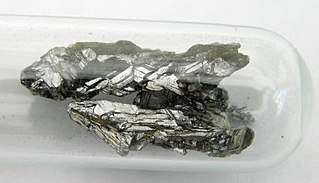Related Research Articles

Arsenic is a chemical element; it has symbol As and atomic number 33. Arsenic occurs in many minerals, usually in combination with sulfur and metals, but also as a pure elemental crystal. Arsenic is a notoriously toxic metalloid. It has various allotropes, but only the grey form, which has a metallic appearance, is important to industry.

Arsenic poisoning is a medical condition that occurs due to elevated levels of arsenic in the body. If arsenic poisoning occurs over a brief period of time, symptoms may include vomiting, abdominal pain, encephalopathy, and watery diarrhea that contains blood. Long-term exposure can result in thickening of the skin, darker skin, abdominal pain, diarrhea, heart disease, numbness, and cancer.

Water purification is the process of removing undesirable chemicals, biological contaminants, suspended solids, and gases from water. The goal is to produce water that is fit for specific purposes. Most water is purified and disinfected for human consumption, but water purification may also be carried out for a variety of other purposes, including medical, pharmacological, chemical, and industrial applications. The history of water purification includes a wide variety of methods. The methods used include physical processes such as filtration, sedimentation, and distillation; biological processes such as slow sand filters or biologically active carbon; chemical processes such as flocculation and chlorination; and the use of electromagnetic radiation such as ultraviolet light.

Sand filters are used as a step in the water treatment process of water purification.

Hexavalent chromium (chromium(VI), Cr(VI), chromium 6) is chromium in any chemical compound that contains the element in the +6 oxidation state (thus hexavalent). The hexavalent form rarely occurs naturally.
In chemistry, an arsenite is a chemical compound containing an arsenic oxyanion where arsenic has oxidation state +3. Note that in fields that commonly deal with groundwater chemistry, arsenite is used generically to identify soluble AsIII anions. IUPAC have recommended that arsenite compounds are to be named as arsenate(III), for example ortho-arsenite is called trioxidoarsenate(III). Ortho-arsenite contrasts to the corresponding anions of the lighter members of group 15, phosphite which has the structure HPO2−3 and nitrite, NO−2 which is bent.

Ashok Gadgil Is the Andrew and Virginia Rudd Family Foundation Distinguished Chair and Professor of Safe Water and Sanitation at the University of California, Berkeley. He is a Faculty Senior Scientist and has served as director of the Energy and Environmental Technologies Division at Lawrence Berkeley National Laboratory.
The Grainger challenge is a scientific competition to find an economical way to remove arsenic from arsenic-contaminated groundwater. This competition is being funded by the United States National Academy of Engineering and the Grainger Foundation and is meant to help provide safe drinking water to countries such as Bangladesh, India, and Cambodia.

Arsenic contamination of groundwater is a form of groundwater pollution which is often due to naturally occurring high concentrations of arsenic in deeper levels of groundwater. It is a high-profile problem due to the use of deep tube wells for water supply in the Ganges Delta, causing serious arsenic poisoning to large numbers of people. A 2007 study found that over 137 million people in more than 70 countries are probably affected by arsenic poisoning of drinking water. The problem became a serious health concern after mass poisoning of water in Bangladesh. Arsenic contamination of ground water is found in many countries throughout the world, including the US.
Abul Hussam is the inventor of the Sono arsenic filter. He is a chemistry professor at George Mason University (GMU) in Fairfax, Virginia, and a member of advisory board at Shahjalal University of Science and Technology.
Green nanotechnology refers to the use of nanotechnology to enhance the environmental sustainability of processes producing negative externalities. It also refers to the use of the products of nanotechnology to enhance sustainability. It includes making green nano-products and using nano-products in support of sustainability.
Slingshot is a water purification device created by inventor Dean Kamen. Powered by a Stirling engine running on a combustible fuel source, it claims to be able to produce drinking water from almost any source by means of vapor compression distillation, requires no filters, and can operate using cow dung as fuel.

Bangladesh is faced with multiple water quality and quantity problems along with regular natural disasters, such as cyclones and floods. Available options for providing safe drinking water include tubewells, traditionally dug wells, treatment of surface water, desalination of groundwater with high salinity levels and rainwater harvesting.
Copper zinc water filtration is a high-purity brass water filtration process that relies on the redox potential of dissolved oxygen in water in the presence of a zinc anode and copper cathode. It uses dissolved impurities within water as constituent substrate, which are reduced to more physiologically inert compounds.

Groundwater pollution occurs when pollutants are released to the ground and make their way into groundwater. This type of water pollution can also occur naturally due to the presence of a minor and unwanted constituent, contaminant, or impurity in the groundwater, in which case it is more likely referred to as contamination rather than pollution. Groundwater pollution can occur from on-site sanitation systems, landfill leachate, effluent from wastewater treatment plants, leaking sewers, petrol filling stations, hydraulic fracturing (fracking) or from over application of fertilizers in agriculture. Pollution can also occur from naturally occurring contaminants, such as arsenic or fluoride. Using polluted groundwater causes hazards to public health through poisoning or the spread of disease.

M. Feroze Ahmed achieved excellence in teaching, engineering profession and scientific research and earned national and international recognition and awards as an eminent professor, civil engineer and scientist. He is the former vice-chancellor of Stamford University Bangladesh.

Bangladesh, with an area of 147,570 km2, features a flood plain landscape and several river systems throughout the country. This landscape provides the major natural resources of water, land, fisheries, forests, and wildlife. The country currently faces several environmental issues which threaten these resources, including groundwater metal contamination, increased groundwater salinity, cyclones and flooding, and sedimentation and changing patterns of stream flow due to watershed mismanagement. Some of these, such as the changing patterns of stream flow and presence of lead in groundwater, can be directly correlated with human activity and industrial processes, while others, such as cyclones and flooding are naturally occurring issues.

Janet Gordon Hering is the former Director of the Swiss Federal Institute of Aquatic Science and Technology and Professor emeritus of Biogeochemistry at ETH Zurich and EPFL. She works on the biogeochemical cycling of trace elements in water and the management of water infrastructure.

Abhijit Mukherjee is an Indian professor, scientist and currently Professor of Geology and Geophysics and the School of Environmental Science and Engineering of IIT Kharagpur. He has been selected for Shanti Swarup Bhatnagar Prize for Science and Technology in 2020 in the field of Earth Atmosphere Ocean and Planetary Sciences.
References
- ↑ Hussam, Abul; Munir, Abul K. M. (2007). "A simple and effective arsenic filter based on composite iron matrix: Development and deployment studies for groundwater of Bangladesh". Journal of Environmental Science and Health, Part A. 42 (12): 1869–1878. doi:10.1080/10934520701567122. PMID 17952788. S2CID 15011364.
- ↑ National Academies Press Release, accessed 5 Feb 2007.
- ↑ Professor wins $1 million for arsenic filter Archived 2007-02-06 at the Wayback Machine , Associated Press, 2/3/07.